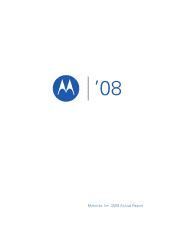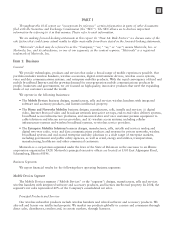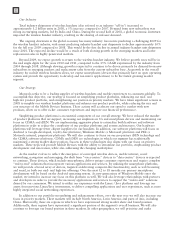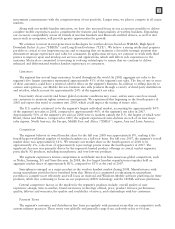Motorola 2008 Annual Report Download - page 11
Download and view the complete annual report
Please find page 11 of the 2008 Motorola annual report below. You can navigate through the pages in the report by either clicking on the pages listed below, or by using the keyword search tool below to find specific information within the annual report.
investments commensurate with the competitiveness of our portfolio. Longer term, we plan to compete in all major
markets.
Along with our mobile handset initiatives, we have also increased focus in our accessories portfolio to deliver
complete mobile experiences and to complement the features and functionalities of wireless handsets. Expanding
our accessory compatibility across all brands of wireless handsets and Bluetooth-enabled devices, as well as into
spaces such as navigation, will provide greater opportunities for growth.
We continue to invest in next-generation technologies for wireless devices based on WiMAX, High-Speed
Downlink Packet Access (“HSDPA”) and Long-Term Evolution (“LTE”). We believe a strong intellectual property
portfolio is critical to our long-term success and to ensuring that we maintain a favorable strategic position that
demonstrate unique experiences and value for consumers. In application services, we continue to work with third
parties to improve upon and develop our services and applications, which will deliver rich experiences to the
customer. Motorola is committed to investing in evolving technologies to ensure that we continue to deliver
enhanced and differentiated wireless handset experiences to consumers.
Customers
The segment has several large customers located throughout the world. In 2008, aggregate net sales to the
segment’s five largest customers represented approximately 41% of the segment’s net sales. The loss of one or more
of these customers could have a material adverse effect on the segment’s business. In addition to selling directly to
carriers and operators, our Mobile Devices business also sells products through a variety of third-party distributors
and retailers, which account for approximately 24% of the segment’s net sales.
Uncertainty about current and future global economic conditions may cause, and in some cases has caused,
our customers to maintain tighter inventory management. We experienced this beginning in the fourth quarter of
2008 and expect this trend to continue into 2009, which could impact the timing of future sales.
The U.S. market continued to be the segment’s largest individual market, accounting for approximately 44%
of the segment’s net sales in 2008, compared to approximately 46% of the segment’s net sales in 2007.
Approximately 56% of the segment’s net sales in 2008 were to markets outside the U.S., the largest of which were
Brazil, China and Mexico. Compared to 2007, the segment experienced sales declines in each of its four major
sales regions: North America, the Europe, Middle East and Africa (“EMEA”) region, Asia and Latin America.
Competition
The segment believes its overall market share for the full year 2008 was approximately 8%, making it the
fourth-largest worldwide supplier of wireless handsets on a full-year basis. For full year 2007, the segment’s overall
market share was approximately 14%. We estimate our market share in the fourth quarter of 2008 to be
approximately 6%, a decrease of approximately 6 percentage points versus the fourth quarter of 2007. The
significant decrease was primarily driven by the segment’s limited product offerings in critical market segments,
particularly 3G products, including smartphones, and very low-tier products.
The segment experiences intense competition in worldwide markets from numerous global competitors, such
as Nokia, Samsung, LG and Sony-Ericsson. In 2008, the five largest handset manufacturers together held an
aggregate market share of approximately 80%, compared to 83% at the end of 2007.
Smartphones emerged as a major product in the wireless handset market during 2008. Manufacturers with
strong smartphone portfolios have benefited from this. Motorola is committed to enhancing its smartphone
portfolio to compete more effectively and will focus on Android and Windows Mobile software platforms for these
products, while also continuing to focus on our proprietary iDEN technology and the CDMA software platforms.
General competitive factors in the market for the segment’s products include: overall quality of user
experience; design; time-to-market; brand awareness; technology offered; price; product features, performance,
quality, delivery and warranty; the quality and availability of service; and relationships with key customers.
Payment Terms
The segment’s customers and distributors buy from us regularly with payment terms that are competitive with
current industry practices. These terms vary globally and generally range from cash-with-order to 60 days.
3
























